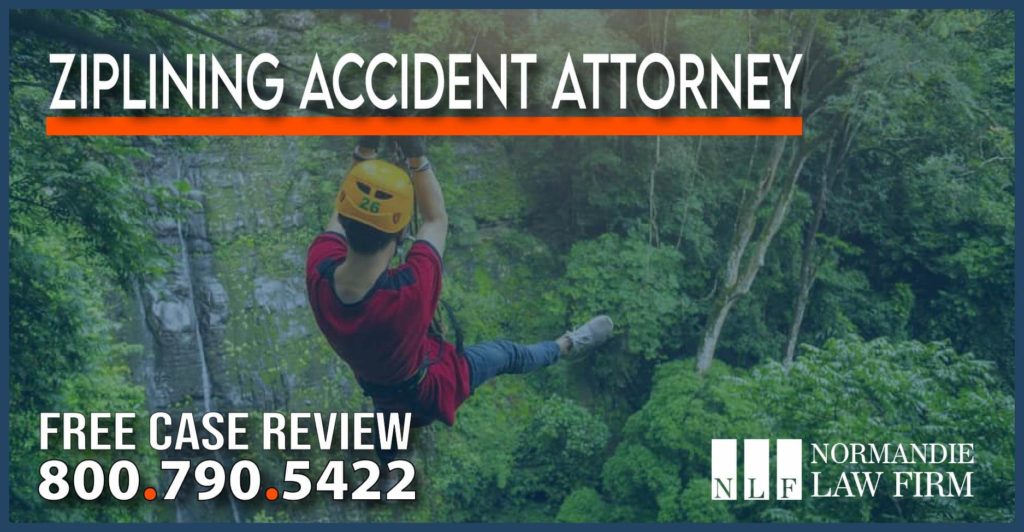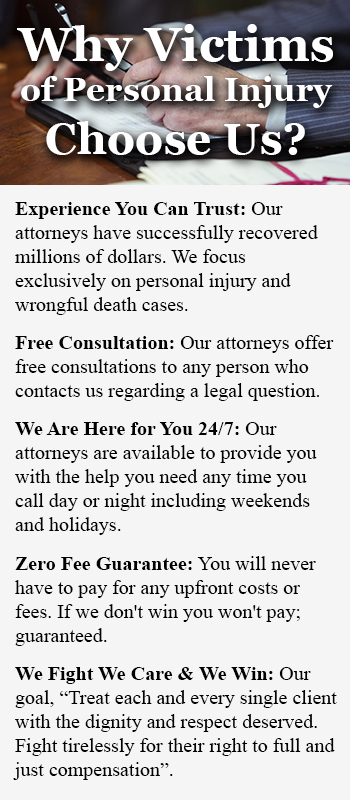Zipline Accident Lawyer
Ziplines are lifelines on steel structures suspended between other supporting units that can attach a pulley system, supporting a person to travers between two points along the zipline. People who take zipline rides do so for the thrills. Ziplines are often supported between trees, in resort areas, or are in wooded areas. This allows people participating in the sport of ziplining to be propelled along the zipline, pulled only by the gravitational forces and the weight of their own body and harnesses to pull them to the end goal on the zipline.
Ziplines are sporting events, where the person on the zipline is participating in maneuvering the zipline. The ziplines must be kept in tip top working order, and be reviewed currently and frequently, to ensure that the ziplines are always safe for the use of the participants.
Zip-Lining Accidents
There are many different types of ziplines. Some zipline courses allow participants to unhook and re-hook themselves along attachment checkpoints along the zipline. Other zipline courses are a straight through gravity pulled course, with one shot to the finished goal area. Although participants do need to sign a waiver to be safe on the zipline at all times, some courses for ziplines never train the participants on how to keep safe while using the zipline.
Our Recent Verdicts and Settlements
$500,000
$599,000
$1.5 Million
$600,000
$525,000
$250,000
Common Causes of Ziplining Accidents
Ziplines can have a zipline course that starts and stops in a variety of different areas of the zipline course. For example, zipline courses can extend:
- Over a body of water
- In a wooded area
- Over a wooded canopy
- On the beach
- On the ground
- Starting on a raised platform going down to the ground
- Over the tree tops landing on a level platform in the trees
There is always the risk of a person participating on a zipline to be injured seriously as a result of an accident on the zipline. These accidents can cause severe and debilitating injuries including:
- Being paralyzed
- Death or injured and later died
- Wrongful death
- Broken foot
- Broken leg
- Broken hand
- Sprained ankle
- Brain injury
- Concussion
- Broken bones
- Exhaustion
- Hypothermia
- Heat exhaustion
If you are injured in a zipline accident, just call us today at the DTLA Law Group to discuss your options to initiate a lawsuit.
Ziplining Accident Lawyer
We understand that you will need time to heal from your injuries sustained on a zipline, from an accident that you just had ziplining. If this is the case, take all the time you need to heal from those injuries. But you don’t have to wait to initiate a lawsuit. Give us a call today, and we can discuss the case with you with full transparency as to your options for settlements with the at-fault parties.
Can I Sue If I Was Injured in a Ziplining Accident?
Yes, you can sue if you were injured in a ziplining accident. You only need to give us a call at the DTLA Law Group to discuss your options to initiate a law suit because of a zipline accident.
Ziplining Accident Lawsuit
If you are injured in an accident with a zipline, you need to call us at the Normandie Law Firm to talk to an attorney specializing in ziplining accidents. When you give us a call today, you can talk with our team of lawyers with experience in zip-lining accidents. We are here for you, and you will get legal advice from our legal team of attorneys in Los Angeles who are experts in ziplining accidents.
When people go onto ziplines, they need to be told by the owners of the zipline how to zipline as safely as possible. The participants to the zipline course need to receive some training on how to zipline safely, and to know how to:
- Brake the zipline apparatus to stop in an emergency
- Get on and off the zipline safely
- Avoid hitting other participants also using the zipline
- Self-rescue on the zipline if necessary
- Know how to preserve the safety of the zipline cable
- Stop using a hand brake if necessary
- Hike a short way to safety on a mountain area if necessary
If you were not taught these safety instructions, then it could be a recipe for disaster. You can call us to discuss the safety of the zipline that you were injured on, and we can advise you of your claim and review your personal injuries to that end.
Can I Sue If I Signed a Waiver?
Yes, you can sue even if you signed a waiver. If you signed a waiver, you can still sue. A zipline liability waiver does not preclude you from bringing an action at law. If the zipline operation is unsafe, then you can bring a lawsuit on the merits of your claim. The zipline company is required to have insurance coverage on their operation. They also need to have regular inspections on the equipment, to guarantee that it is safe, and they need safe operators on all aspects of the zipline operation helping participants to be safe while ziplining.
Unfortunately, many people simply don’t take any action after an accident because they wrongfully believe that they don’t have any right to sue after signing the liability waiver. However, you could still file a lawsuit even if you previously signed a liability waiver. Regardless of a signed liability waiver, you could file a lawsuit on the basis of negligence. So, if you were not given any safety instructions, the zipline was defective, the harness was loose, the clasps were broken, for example, then the company or the operator could be found negligent and accountable of any resulting harm. This is because these companies have a duty to keep their attraction safe; they can be liable for any harm caused by a failure to identify and address risks.
Without a doubt, any company will go above it all to ensure that the liability waiver is upheld. Often times, these companies are simply hiding behind the waiver, as they know that they could certainly be held accountable. This is why it is important to have representation.
Liability waivers are not bulletproof. An experienced lawyer can help you prove that the company/operator was well aware of the dangers present in their zipline. This can be easier if the establishment has had multiple similar incidents in the past. Ultimately, whether or not the waiver is sustained will depend on the judge’s decision. If you beat the waiver, then you will be in a great position – and will likely be eligible to recover damages. On the contrary, if you lose on the waiver matter, then your case will likely be thrown out, and you will not be eligible to recover damages for the harm that you suffered.
For more information about your right to file a zipline injury lawsuit even after signing a liability waiver, contact the experts here at our law firm today.
Ziplining Liability
There will always be some risk if you zipline that you can be injured. Ziplining in some ways can be considered an “extreme” sport. Having said that, it is on the ziplining operation and company to ensure that the zipline is a safely run as possible. This will prevent major injuries from occurring at the operation.
People who are going to use a zipline will come to the operation with a varying degree of experience with ziplining as a sport. Some people will be athletic and ready to roll, while other people will be out of their depth and still want to zipline. In any event, the operation of the zipline is meant to meet the needs of the entire public, and to that end, they are responsible to keep the novices and experienced zipline participants safe at all times.
Ziplines need to be fully inspected regularly, based on the rules of the state where they are located. If the zipline is not inspected on a regular basis, it may be unsafe to operate, which can injure the participants. Some questions to ask the zipline operators regarding inspections might be to inquire as to:
- The last time the zipline was inspected?
- Did the zipline operation pass its required inspections?
- Did an engineer inspect the zipline for safety regulations?
- Did a structural engineer review the zipline for safety compliance?
- Are all licenses up to date for the zipline operator?
- Are all zipline sitting harnesses cleared for safe operation
- Are all zipline combination chest and sit harnesses safe for use?
- Are employees of the zipline company following all OSHA compliance requirements?
Any time that there is an accident or accidental death on the zipline, the owner and operator of the zipline operation needs to shut down the ride to ensure the safety of the public. A full description of the accident with any witnesses needs to be completed, and handed over to the appropriate authorities. There needs to be a notification to the public of the accident, and a description for all injuries needs to be made.

Injured While Ziplining
Ziplining has taken off as a sport in the last decade. With this increase in popularity, ziplines are getting faster and faster, creating more accidents in the wake. Now, some ziplines have increased speeds, which make it difficult for someone to brake safely to avoid a serious accident using the zipline.
Ziplining Injury Lawsuit
Many people are injured on ziplines every year. Over 16,850 people were treated at hospital emergency departments (emergency rooms) for injuries on ziplines in the timeframe from 1997 to 2012, as zipline use gained in popularity as a sport (Bilock et al, 2015). Fractures are the most common injuries from a zipline, but people using a zipline can also die from the use of the zipline if it is unsafe to use. Collision injuries with other zipline participants are also high on the list of reasons for injuries, and unreliable braking systems on the ziplines can cause a serious accident at any time during zipline use.
The Zipline Broke
It is true that a zipline can break during use of a person on the zipline. Ziplines are typically constructed with wooden poles, wire ropes, steel bolts and platforms that hand a few hundred feet in the air. If any one of these components is rotted, not put together properly or breaks down, there can be serious accidents as a result.
The site of the zipline also needs to be determined with care, to review the factors that can affect the safety of the zipline in the future for the participants, including checking the factors related to:
- Topography around the zipline
- Historical weather conditions in the area that will affect the zipline functions
- Supports to the zipline
- Quality of construction materials on the zipline
- Corridor and treetop clearances of the zipline structures
- Geology of the area of the zipline
- Utility poles near the zipline
- Health and vitality of the trees near the zipline
- Obstructions near the zipline
- Physical damage to poles or cables on the zipline
- Displaced and loose wiring near and around the zipline
- Broken wires near the zipline
- Frayed wires on the zipline
- Frayed harnesses and broken helmets for use of the participants
- Frayed gloves for use of the participants
- Failure to reset brakes on the zipline
- Miscommunication of the zipline operators during participant use timeframes
- Inadequate and missing protocols for rescue procedures after an accident on the zipline
- Lack of and poor training of operators monitoring the zipline for the company
- Lines not cleared downstream for participants going on the zipline
- Ropes not rated for size and weight of all various participants
- Use of trees as anchor points need to meet integrity and support compliance requirements from a certified arborist or licensed structural engineer
- Harnesses need to be tested before used by the public
- Regular inspection for fall safety gear for use by the public
- Braking using only double padded gloves to prevent injury
- Emergency arrest devices in place to offer braking option if braking apparatus fails during an emergency or accident
- Daily inspection of cable diameter reduction for safety of participants
- All aspects of the cables need to be checked daily for safety concerns
- Appropriate rankings placed on the ziplines to designate beginner, intermediate, advanced and expert levels of ziplines for participant use
- Posted weight requirements for all zipline areas
If your zipline had a safety hazard, you would not have known about this before using the zipline. But the owners and operators should have known about these defects in the zipline, and corrected all unsafe conditions before opening the zipline to the public.
Personal Injury Lawyer for Zipline Injuries
If you have been seriously injured on a zipline, you need to talk to the attorneys who are experts on personal injuries from a zipline accident. Just pick up your smartphone this afternoon, and call us at the DTLA Law Group right now. We are here for you and on your side. We can get you taken care of the way you need to be, and get you the recovery compensation that you need now to cover your personal injuries sustained on a zipline accident.
Zipline Death
People using a zipline can lose their life and die on the zipline. This can come because of an incident such as a:
- Fall from the zipline to the ground
- Collision with other zipliners
- Crashing into sides of posts or trees
- Getting stuck on the zipline
- Unable to use the brakes on a zipline
- Getting tangled in the zipline
- Zipline tethers melting from too much friction on the zipline
- Head traumas from zipline crashes turn into comas and then death
- Falling as an employee trying to save a participant on the zipline during an accident
- Falling from 50-100 feet from the zipline
- Striking a pole or a tree
If your family member has died using a zipline, you need to call our law firm at the DTLA Law Group immediately. We are here to answer your call, and all questions that you have related to settlement of your claim for the at-fault parties. Call now!
Wrongful Death Claim by Family Members
If you have had a loved one who died using a zipline for a sport filled afternoon, you need to call us this afternoon. We understand your situation, and we can work with you to get the money you are due in this type of wrongful death claim. We know how to manage, negotiate and work with the big insurance companies on a wrongful death claim. We are here to get you the full compensation package for recovery compensation that you deserve, in this type of a claim.
Call Us for a Free Consultation
You can call us today for a free consultation, if you are personally injured on a zipline. We understand that you need time to heal from your injuries, but that won’t stop you from picking up your phone and calling us today. We are here for you, and can help you get the recovery compensation that you need. Your medical bills related to your zipline accident will start coming in hot and heavy right about now, just call us to get this sorted out as quick as possible.
Other Pages on Our Website Related to This Topic
Statute of Limitations for a Ziplining Accident Lawsuit
How long does it take for a Zip-Lining Accident Case to Settle
References
Billock, R. M., Anderegg, J. J., Mehan, T. J., Chounthirath, T., & Smith, G. A. (2015). Zipline-related injuries treated in US EDs, 1997-2012. The American Journal of Emergency Medicine, 33(12), 1745–1749. https://doi.org/10.1016/j.ajem.2015.08.022.












